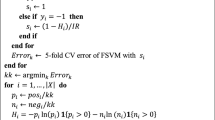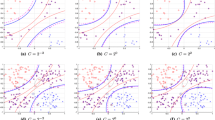Abstract
Compared with traditional computational intelligence techniques such as the support vector machine, extreme learning machine (ELM) provides better generalization performance at a much faster learning speed without tuning model parameters. Unfortunately, the training process of ELM is still sensitive to the outliers or noises in the training set. On the other hand, when it comes to imbalanced datasets, ELM produces suboptimal classification models. In this paper, a kernel possibilistic fuzzy c-means clustering-based ELM algorithm for class imbalance learning (CIL) is developed to handle the class imbalance problem in the presence of outliers and noises. A set of experiments are conducted on several artificial and real-world imbalanced datasets for testing the generalization performance of the proposed algorithm. Additionally, we compare its performance with some typical CIL methods. The results indicate that the proposed method is a very effective method for CIL, especially in the presence of outliers and noises in datasets.




Similar content being viewed by others
Explore related subjects
Discover the latest articles, news and stories from top researchers in related subjects.References
Taylor JG. Cognitive computation. Cogn Comput. 2009;1(1):4–16.
Grassi M, Cambria E, Hussain A, Piazza F. Sentic web: a new paradigm for managing social media affective information. Cogn Comput. 2011;3(3):480–9.
Wöllmer M, Eyben F, Graves A, Schuller B, Rigoll G. Bidirectional LSTM networks for context-sensitive keyword detection in a cognitive virtual agent framework. Cogn Comput. 2010;2(3):180–90.
Cambria E, Hussain A. Sentic computing: techniques, tools, and applications. SpringerBriefs in cognitive computation. Dordrecht: Springer; 2012.
Wang QF, Cambria E, Liu CL, Hussain A. Common sense knowledge for handwritten Chinese recognition. Cogn Comput. 2013;5(2):234–42.
Cambria E, Hussain A. Sentic album: content-, concept-, and context-based online personal photo management system. Cogn Comput. 2012;4(4):477–96.
Mital P, Smith T, Hill R, Henderson J. Clustering of Gaze During Dynamic Scene Viewing is Predicted by Motion. Cogn Comput. 2011;3(1):5–24.
Wang G, Zhao Y, Wang D. A protein secondary structure prediction frame- work based on the extreme learning machine. Neurocomputing. 2008;72(1–3):262–8.
Lan Y, Soh YC, Huang G-B. Extreme learning machine based bacterial protein subcellular localization prediction. In: Proceedings of the IEEE International Joint Conference on Neural Networks, IJCNN 2008, Hong Kong, 2008. p. 1859–1863.
Zhang R, Huang G-B, Sundararajan N, Saratchandran P. Multicategory classification using an extreme learning machine for microarray gene expression cancer diagnosis. IEEE/ACM Trans Comput Biol Bioinform. 2007;4(3):485–95.
Mohammed AA, Minhas R, Jonathan Wu QM, Sid-Ahmed MA. Human face recognition based on multidimensional PCA and extreme learning machine. Pattern Recogn. 2011;44(10–11):2588–97.
Nizar AH, Dong ZY, Wang Y. Power utility nontechnical loss analysis with extreme learning machine method. IEEE Trans Power Syst. 2008;23(3):946–55.
Decherchi S, Gastaldo P, Dahiya RS, Valle M, Zunino R. Tactile data classification of contact materials using computational intelligence. IEEE Trans Robot. 2011;27(3):635–9.
Decherchi S, Gastaldo P, Zunino R, Cambria E, Redi J. Circular-ELM for the reduced-reference assessment of perceived image quality. Neurocomputing. 2013;102:78–89.
Cambria E, Huang G-B, Kasun LLC, et al. Extreme learning machines [Trends & Controversies]. IEEE Intell Syst. 2013;28(6):30–59.
Amaury L, Qing H, Yoan M. Advances in extreme learning machines (ELM2012). Neurocomputing. 2014;128:1–3.
Zong W, Huang G-B, Chen Y. Weighted extreme learning machine for imbalance learning. Neurocomputing. 2013;101:229–42.
Mazurowski MA, Habas PA, Zurada JM, et al. Training neural network classifiers for medical decision making: the effects of imbalanced datasets on classification performance. Neural Netw. 2008;21(2):427–36.
Imam T, Ting K, Kamruzzaman J. z-SVM: an SVM for improved classification of imbalanced data. In: Proceedings of the 19th Australian Joint Conference on Artificial Intelligence, Hobart, Australia, 2006, pp. 264–273.
Soda P. A multi-objective optimisation approach for class imbalance learning. Pattern Recogn. 2011;44(8):1801–10.
Huang HP, Liu YH. Fuzzy support vector machines for pattern recognition and data mining. Int J Fuzzy Syst. 2002;4(3):826–35.
Lin CF, Wang SD. Fuzzy support vector machines. IEEE Trans Neural Netw. 2002;13(2):464–71.
Yang X, Zhang G, Lu J. A kernel fuzzy c-means clustering-based fuzzy support vector machine algorithm for classification problems with outliers or noises. IEEE Trans Fuzzy Syst. 2011;19(1):105–15.
Batuwita Rukshan, Palade Vasile. FSVM-CIL: fuzzy support vector machines for class imbalance learning. IEEE Trans Fuzzy Syst. 2010;18(3):558–71.
Yang MS, Tsai HS. A Gaussian kernel-based fuzzy c-means algorithm with a spatial bias correction. Pattern Recognit Lett. 2008;29:1713–25.
Rhee FCH, Choi KS, Choi BI. Kernel approach to possibilistic c-means clustering. Int J Intell Syst. 2009;24:272–92.
Chen Z, Shixiong X, Bing L. A robust fuzzy kernel clustering algorithm. Appl Math Inf Sci. 2013;7(3):1005–12.
Seiffert C, Khoshgoftaar TM, Van Hulse J, et al. RUSBoost: a hybrid approach to alleviating class imbalance. Syst Man Cybern Part A Syst Hum IEEE Trans. 2010;40(1):185–97.
Haibo H, Garcia E. Learning from imbalanced data. IEEE Trans Knowl Data Eng. 2009;21(9):1263–84.
Galar M, Fernández A, Barrenechea E, et al. A review on ensembles for the class imbalance problem: bagging-, boosting-, and hybrid-based approaches. Syst Man Cybern Part C Appl Rev IEEE Trans. 2012;42(4):463–84.
García V, Sánchez JS, Mollineda RA. On the effectiveness of preprocessing methods when dealing with different levels of class imbalance. Knowl-Based Syst. 2012;25(1):13–21.
Ditzler G, Polikar R, Chawla N. An incremental learning algorithm for non-stationary environments and class imbalance. In: Pattern Recognition (ICPR), 2010 20th International Conference on IEEE, 2010. p. 2997–3000.
Burez J, Van den Poel D. Handling class imbalance in customer churn prediction. Expert Syst Appl. 2009;36(3):4626–36.
Wang S, Yao X. Multiclass imbalance problems: analysis and potential solutions. Syst Man Cybern Part B Cybern IEEE Trans. 2012;42(4):1119–30.
Pang S, Zhu L, Chen G, et al. Dynamic class imbalance learning for incremental LPSVM. Neural Netw. 2013;44:87–100.
Alejo R, Valdovinos RM, García V, et al. A hybrid method to face class overlap and class imbalance on neural networks and multi-class scenarios. Pattern Recogn Lett. 2012;34(4):380–8.
Lin SJ, Chang C, Hsu MF. Multiple extreme learning machines for a two-class imbalance corporate life cycle prediction. Knowl-Based Syst. 2012;39:214–23.
Tahir MA, Kittler J, Yan F. Inverse random under sampling for class imbalance problem and its application to multi-label classification. Pattern Recogn. 2012;45(10):3738–50.
Chen WC, Hsu CC, Hsu JN. Adjusting and generalizing CBA algorithm to handling class imbalance. Expert Syst Appl. 2012;39(5):5907–19.
García-Pedrajas N, Pérez-Rodríguez J, García-Pedrajas M, et al. Class imbalance methods for translation initiation site recognition in DNA sequences. Knowl-Based Syst. 2012;25(1):22–34.
Acknowledgments
This work was supported by “the Fundamental Research Funds for the Central Universities” under Grant No. 2014QNA45.
Author information
Authors and Affiliations
Corresponding authors
Rights and permissions
About this article
Cite this article
Xia, SX., Meng, FR., Liu, B. et al. A Kernel Clustering-Based Possibilistic Fuzzy Extreme Learning Machine for Class Imbalance Learning. Cogn Comput 7, 74–85 (2015). https://doi.org/10.1007/s12559-014-9256-1
Received:
Accepted:
Published:
Issue Date:
DOI: https://doi.org/10.1007/s12559-014-9256-1




